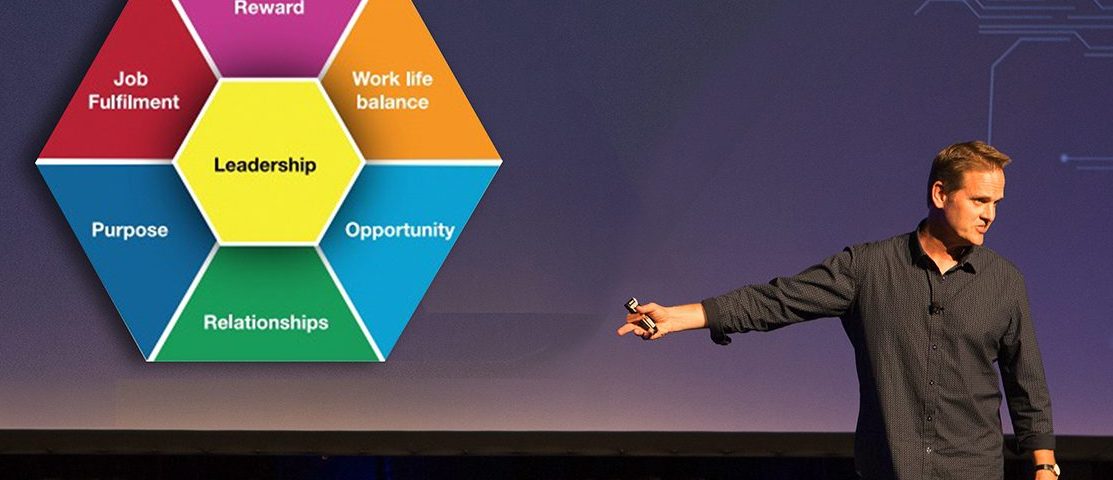DNA of Employee Engagement

DNA of Employee Engagement
How Organisations Can Foster Individual Ownership of Employee Engagement
Ever considered most organisations have it all wrong and need to flip employee engagement on its head and see it from the employees’ point of view?
Tired of using the same old employee engagement strategies and just not getting the results you want?
Looking for an intelligent and effective employee engagement approach?
80% of Employee Engagement Can Be Employee Driven
The latest proven research from employee engagement expert, Ian Hutchinson, shows that most employee engagement drivers can be controlled, to a large degree, by the individual employee themselves. This new self-responsibility paradigm shift is what employee engagement speaker and author of People Glue: Employee Engagement and Staff Retention Solutions That Stick!, Ian Hutchinson, has coined ‘Employee Driven Engagement’.
Through Ian’s research consulting with hundreds of organisations over the past two decades on employee engagement, he has found that most employees know what doesn’t engage and motivate them, but fewer know what really does engage and motivate them.
This lack of employee awareness creates a serious cultural engagement issue, because if employees don’t know what truly motivates them, then the organisation’s ability, as well as their leaders’ chances of successfully maximising employee engagement, are greatly diminished.
The Self-Responsibility Approach
To get real cut-through, successful employee engagement needs to have a cultural self-responsibility approach. This approach needs to incorporate self-leadership initiatives, to help employees get clarity, as well as personal empowerment and put them in the driver’s seat, to maximise their own performance, productivity, motivation and employee engagement.
The Problem With Current Employee Engagement Approaches
Many organisations have been diligently beavering away, doing their regular employee engagement research, with most spending 80% of their time on the research and only 20% on generic implementation based on the findings.
As such, many HR leaders get frustrated unable to get ahead and even slipping behind in their employee engagement scores.
The Old School Top-Down Approach to Employee Engagement
The reason? … They are trying to do the same old broad brush, umbrella solutions to enhance employee engagement.
Sure HR has been restricted with budget and increasing time pressure. So typically the way forward has always been: the research is complete, let’s implement broad brush, umbrella strategies to try and solve the weaknesses (and then cross our fingers that the workforce will be relatively satisfied). That’s the top-down approach.
The quicker organisations and human resources understand that the ‘one-size-fits-all’ concept hasn’t ever really been effective (and never will) the better.
Companies have also got in the habit of showering their employees with superficial gifts and benefits with the misguided hope of trying to improve employee engagement scores. In more cases than not, providing of gifts and benefits has simply created ‘spoilt brat employees’ and borne a ‘whinge entitlement culture’.
The Bottom-Up Approach to Employee Engagement
The proven and most effective employee engagement approach is from the bottom-up. This approach is where every employee is seen as an individual, and instead of general Organisational Engagement Plans (OEP) being the focus, individuals do Personal Engagement Plans (PEP) where the focus is on individuals being encouraged (and in many occasions, facilitated) to be responsible for getting clarity on what personally engages and motivates them, and then putting in place strategies to ensure they can drive their own fulfilment.
Employee clarity, or the lack there of, is the major obstacle to why improving employee engagement hasn’t worked properly in the past for most organisations.
Enlightened Employee Engagement – Clarity Creates Control
Enlightened organisations, are increasingly realising that assisting individual employees get clarity on what engages and motivates them is the key to improving employee engagement.
There are three problems if employees don’t really know what engages and motivates them (employee clarity):
1. Individuals will default to financial reward as their primary employee engagement driver and can easily reinforce a ‘whinge entitlement’ culture.
2. Managers and leaders will have virtually no chance of really engaging them.
3. Individuals can’t take responsibility for their personal engagement because they don’t know what’s really important to them.
Again, very few employees really know what truly engages and motivates them in their work. If employees don’t know, then HR and managers can’t know either. In this scenario, as mentioned, the default engagement driver then usually becomes ‘give me more money’, which is a very expensive and ineffective way of trying to engage and motivate employees.
The good news is, after research working with hundreds of organisations, Ian Hutchinson has clearly identified that 80% of employee engagement can be improved by individual employees themselves – it’s just that most aren’t aware of it yet.
The 7 Employee Engagement Drivers
The 7 employee engagement (and motivational) drivers are based on years of employee engagement & motivation research. In fact they are quite simple. Simplifying these drivers down to 7 means that, right across the organisation, you can have this easy, but powerful, conversation around what engages and motivates individuals. Better still, tools, templates and worksheets to further aid this discussion piece.
The key is knowing these drivers and having all people leaders understand them. Do this and you are well on the way to embedding a common, motivational engagement language within your organisation that will maximise your chances of unlocking employee engagement.
The 7 motivational engagement drivers are (in no particular order):
1. Leadership
2. Purpose
3. Reward
4. Opportunity
5. Relationships
6. Job Fulfilment
7. Work Life Balance
Remember, everyone is going to be different in terms of the order of what those are.
Kick-Start Personal Engagement Plans (PEP)
Using these seven motivational engagement drivers in a ‘stay interview’ discussion or performance review should now be the baseline – engagement 101.
The reason most organisations and their managers haven’t done this in the past is simply because they haven’t had these employee engagement tools, systems or know how. Many people leaders have been locked into the paradigm that employee engagement is an HR issue, or that they personally don’t have the soft skills to properly facilitate an engagement & motivational driver discussion with their direct reports.
Only Requires 1% Of Your Time
Doesn’t this approach make it more challenging for people leaders to manage individual employees’ expectations?
Ian Hutchinson, Chief Engagement Officer at LifebyDesign.com.au says for example, that everyone in his team are engaged and motivated by a different set of employee engagement drivers. Ian says to maximise productivity and performance of all employees, it’s vital to know what each individual’s top three engagement drivers are – then it’s just a matter of keeping on top of them through their Personal Engagement Plans (PEP).
He says it’s sometimes counter-intuitive thinking this bottom-up, self-responsible, employee-driven engagement approach takes more work. But it ultimately saves time, improves productivity and performance and makes HR and leaders’ jobs easier, with more engaged and motivated employees.
It’s consistently been proven that a quick,15-minute coffee chat/ PEP check-in (equating to 1% of an average work day) with each direct report, can save weeks and month of time in improved engagement, motivation, productivity and performance.
Ian’s definition of leadership is being a catalyst to increase productivity and performance (in the nicest possible way through engagement). Therefore it should now be a leader’s priority looking after their number one customer – their employees.
Who Should Be Responsible for Employee Engagement?
Hutchinson says that everyone should be responsible for engagement. Sure, the old model of employee engagement suggests that human resources should be responsible for Organisational Engagement Plans (OEP); but even better is getting people leaders responsible for creating Team Engagement Plans (TEP); however the most effective approach is getting individual employees to take responsibility for their Personal Engagement Plans (PEP).
For more information Ian does employee engagement speaking and training globally and has created mobile friendly e courses, tools and systems for individual employees, people leaders and HR.
Employee Driven Engagement: Conclusion
The overall objective is to shift the paradigm of the employment relationship to one of Employee Driven Engagement. Move away from providing extrinsic benefits to employees, and shift to having individuals taking responsibility for their own engagement and motivation intrinsically with self-leadership and personal responsibility. But it all starts with the organisation being the catalyst to getting your people clear on what engages and motivates them.
The key is to have solutions for individuals with simple tools for change that stick, rather than just a fad that is here today and gone tomorrow. Successfully embedding this employee driven engagement approach has proven to be the new employer-employee ‘win-win’.
Get Your FREE People Glue Book 48 Page Extract
As a way of saying thanks for being part of our Life by Design community we are releasing an extract from Ian Hutchinson’s People Glue:Employee Engagement And Staff Retention Solutions That Stick! book. 48 pages of thought provoking content on how to change the landscape of employee engagement as we know it now!
Employee Engagement Tools & Resources
Employee Driven Engagement – Introductory Webinar Recording
Join Ian Hutchinson, Employee Driven Engagement expert and author of People Glue: Employee Engagement & Retention Solutions That Stick! on a 60
mins webinar.



